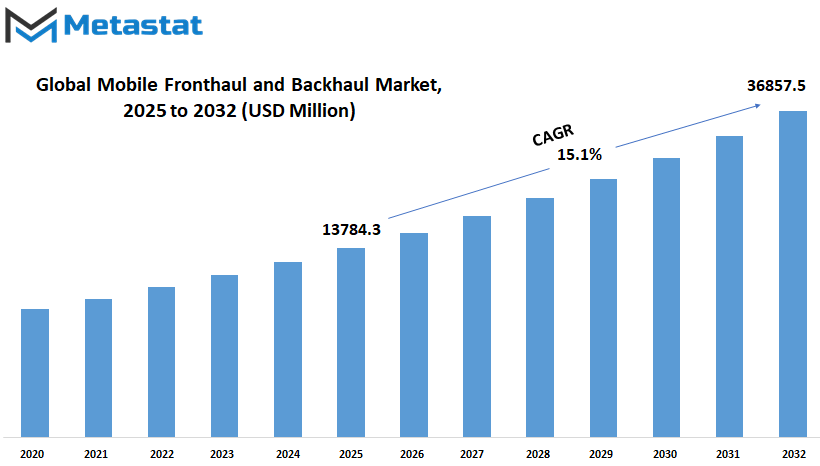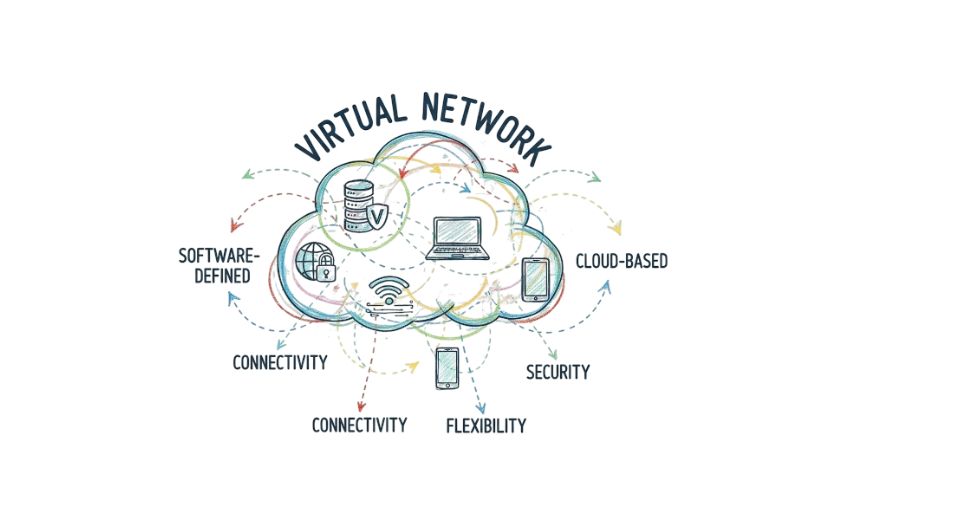MARKET OVERVIEW
The Global Mobile Fronthaul and Backhaul market and business are in transition due to evolving infrastructure for wireless communication networks. The importance of this market lies in its ability to transmit data between the various elements of a mobile network, thereby enabling low-latency connectivity with the high-capacity communication necessary in today’s scenarios.
As the spheres of telecommunication networks grow, so much more demand for fronthaul and backhaul solutions will grow, thus changing the technological landscape and data flow in networks. Fronthaul and backhaul refer to different sections of the data transport path in a mobile network. Fronthaul connects remote radio units (RRUs) to house the centralized baseband units (BBUs) so that signal processing and network optimization can be performed efficiently.
Backhaul connects the BBUs to the core network for uninterrupted interconnectivity between cell sites and central data processing hubs. These drive paths intertwine to form the backbone of modern wireless communication, with heavy data-bearing applications. With the expansion of 5G technology, the market will witness another set of transformation.
Network operators will have the ability to use higher-frequency bands, implying shorter transmission distances as well as more efficient fronthaul and backhaul solutions. Fiber-optic networks will develop as a front runner in high-speed data transfer and low latency. Also, microwave and millimeter-wave technology will continue to open doors in areas where installing fiber will not be feasible. An added benefit will be increased flexibility due to a growing SDN and NFV integration, allowing for efficient resource allocation across communication networks.
The market will have a wider range of applications in the different regions, where cities will strive for technological advancement and rural deployments will focus on closing the gap in connectivity. Emerging economies will have a considerable share in market growth with lots of mobile penetration and government interest in digital transformation. The ongoing move to cloud-native architectures will improve network infrastructure specifications, giving rise to new opportunities for vendors, service providers, and infrastructure developers.
With 5G, ultra-reliable and low-latency communication will reshape the architectures of networks. The Global Mobile Fronthaul and Backhaul market will be the benefactor by optimizing transport networks for real-time data processing near the end user. This transformation will allow a host of applications ranging from smart cities, to autonomous vehicles, to industrial automation, all of which rely on seamless and speedy data transfer.
Looking ahead, the Global Mobile Fronthaul and Backhaul market might be accepted by network operators and service providers that will explore implementing hybrid networks combining fiber, wireless, and satellite-based technologies to meet different connectivity requirements. Investments into artificial intelligence and machine learning will also refine the network further, leading to the equalization of network performance in terms of automated traffic management and predictive maintenance. With the maturity of these technologies, they will shape how networks cater to dynamic demands, giving preference to the best bandwidth allocation and overall efficiency.
Yet again, the regulatory framework that will govern the market will push the direction of the market, determining how spectrum is eventually allocated and therefore what infrastructure will be built. Policies that will encourage open-access networks and shared infrastructure will create new business models and heighten partnerships among telecom operators and vendors of technology. Sustainable infrastructure solutions will become relevant as their focus is redirected towards energy-efficiency networking equipment and eco-friendly deployment strategies as the consumption of data goes further.
For the next few years, the Global Mobile Fronthaul-and-Backhaul market shall be in a forever state of transformation, so as to respond to the market requirements of high-speed connectivity and advanced digital services. The fusion of new-age technologies, focused investments and regulatory environments will define the future landscape of the market, ensuring the agility and resilience of communication networks in sustaining Next-Generation Communication Services.
Global Mobile Fronthaul and Backhaul market is estimated to reach $36857.5 Million by 2032; growing at a CAGR of 15.1% from 2025 to 2032.

GROWTH FACTORS
The global mobile fronthaul and backhaul market holds potential promise in the years to come. The fronthaul and backhaul market are growing due to several factors, primary among them being the global and quick adoption of 5G technology, thus requiring advanced fronthaul and backhaul to meet the demand for increased data traffic and connectivity. Again, as more devices link their lives with that of persons, the need for robust and real-time network infrastructures intensifies, thus further shaping the future of this emerging market.
Of course, IoT device proliferation continues to take that upward swing; the world becomes more automated: smart homes, wearable technology, and increasingly, automated machines for industry. To manage this expansion in connected devices, the networks need to cater to huge volumes. Mechanical-to-automated IoT applications need to be connected through efficient fronthaul and backhaul solutions for reliable data transfer and latency reduction.
There are, however, some challenges in the market which might prevent them from attaining their predicted market growth. The first of these would include the high cost of infrastructure upgrading as part of deployments; this can be a significant hurdle for many small operators. There are regulatory hurdles, as well as spectrum allocation issues, in various regions that can slow the implementation of such new technologies, thus stalling the entire market development.
However, the possibility of given technology improvements creates new opportunities. Software-defined networking (SDN) and network function virtualization (NFV) developments support more flexible and more affordable management of networks. Using these techniques, operators optimize their networks dynamically by lowering operational expenditures and improving the quality of their services.
The market avenue, therefore, broadens significantly, with emphasis shifting to the rural and unserviced areas. Specifically, governments and other organizations make investments in extending the coverage of their networks into these areas. This requires substantial infrastructure development involving extensive fronthaul and backhaul systems. Consequently, it would not only ensure the narrowing of the digital divide but opens up new opportunities to service providers in the market.
Therefore, the Global Mobile Fronthaul and Backhaul market does face some challenges but the wheels seem to be in motion and with the help of the 5G adoption, continual increase in IoT devices, alongside technology advancements and introducing more opportunities into the market, a healthy state of growth is anticipated in the near future.
MARKET SEGMENTATION
By Type
The Global Market is going through restructuring in the upcoming times. The impacts are increasing with the change the mobile networks go through to satisfy new technological demands-mostly by using fronthaul and backhaul systems. Fronthaul means the signal route from centralized bb. Units to remote radio heads at cell sites, while backhaul includes communication from the core network. Units for relaying data through the network.
These changes will accelerate in conjunction with 5G and the forthcoming 6G technologies, requiring mobile communication infrastructure to bear very high data rates and low latencies with extreme connectivity. This would presumably refer to new requirements for fronthaul and backhaul system enhancements. For example, fronthaul networks would need to accommodate massive Multiple-Input, Multiple-Output (MIMO) configurations as well as millimeter-wave frequencies very essential in materializing the next-generation networks’ expectations for high-speed and low-latency requirements.
On the contrary, an unmanageable amount of data traffic due to the wide usage of IoT devices, autonomous vehicles, and augmented reality applications by backhaul systems will trigger either high-capacity fiber optics or advanced wireless technologies to maintain unhindered data flow from core networks to end-user systems.
Besides, edge integration will affect the Global Mobile Front Haul and Backhaul Market. By doing data-processing close to the source, edge computing increases the reduction in latency and increases real-time data handling. This transition will see the fronthaul and backhaul networks’ versatility increased to support distributed computing resources.
Network virtualization combined with the deployment of Software Defined Networks shall also affect the mobile fronthaul and backhauls. The forward management of natural resources results in responsive operators adjusting to the variable traffic and performance optimization.
As the Global Mobile Fronthaul and Backhaul market continues to evolve, collaboration among industry stakeholders will be vital. Stakeholders ranging from equipment manufacturers, network operators, and technology developers must work towards the establishment of standards and development of solutions to the problems plaguing next-generation mobile networks, strongly ensuring that the infrastructure is set to support all the innovative applications and services that will come to characterize the future of mobile communication.
By Fronthaul
The Global Mobile Fronthaul and Backhaul market is likely going to witness quite a change in the years to come. With mobile networks evolving to accommodate the increasing data traffic along with the rising number of connected devices, it is inevitable that the very infrastructure that supports these networks should evolve as well. Supplementary sources for the fronthaul technology development reflect this trend outright, as all centralized radio controllers find a way in forwarding information to and from remote radio units.
Different fronthaul technologies have their own unique features. Optical fronthaul for instance is a kind of fronthaul that uses fiber-optic cables, ensuring high-capacity and low-latency connections. This method helps in providing support to the egress data rates required by present-day applications and services. In contrast, microwave fronthaul consists of an extremely high-frequency transmission and is entirely wireless.
This method is particularly useful in areas where laying fiber-optic cables is not easy or cost-prohibitive. Another fronthaul alternative, copper fronthaul is not really common in newer deployments but is still a good alternative in specific scenarios, especially where existing copper infrastructure can be utilized. Therefore, other fronthaul technologies keep emerging, offered as various alternatives in meeting certain network requirements.
In the future, the Global Mobile Fronthaul and Backhaul market will keep evolving in response to the advances in technology and the increasing demand for seamless connectivity. From 5G and on, the next-generation technologies will develop new fronthaul solutions toward the next frontier. Indeed, as networks become complicated further, and most especially, data and traffic become heavier, the role of the fronthaul infrastructure will become much more efficient and reliable. Therefore, stakeholders in this particular market must keep their feet on the ground and tread these new waters of technology and approaches to fill the ever-changing needs of the global communications landscape.
The Global Mobile Fronthaul and Backhaul market will always be identified with innovative improvement and progressive adaptation. Indeed, by focusing all development and deployment efforts on advanced fronthaul technologies, the industry will ensure that these networks are strong enough and efficient enough to support the demands placed upon them by the connected world of tomorrow.
By Backhaul
The Global Mobile Fronthaul and Backhaul market is expected to witness notable changes over the next couple of years. The members of the mobile network must evolve to meet the requirements of increasing data traffic and the emergence of connected devices, and the infrastructures supporting these networks must also evolve. The main activities of fronthaul and backhaul are to ensure seamless communication between the core network and the end users.
Fronthaul refers to the connection between centralized radio controllers and remote radio units located at the cell sites. Backhaul connects those cell sites to the core network. The combination of both forms the backbone of mobile communications, such that information can flow smoothly, dependably, and in a user-friendly manner.
In future, the backhaul section of the market is expected to evolve into diversified modes, each serving a specific network need. Fiber optic backhaul will remain the prime carrier technology due to its ability to deliver extremely high-capacity low-latency data links for applications such as broadband access. With its extreme data-handling capability, the use of fiber optics will be indispensable for next-generation networks.
Particularly in view of scenarios where it becomes very difficult or too expensive to deploy fiber backhaul, the role of microwave will also become increasingly important. Microwave technology is experiencing advances that increase its capacity and reliability, thus becoming an alternative applicable in both urban and rural settings. This will ensure much-needed connectivity to areas with limited options.
The satellite backhaul market will do well, especially in geographical regions away from terrestrial infrastructure. Low-Earth-orbit satellites address a large concern regarding latency and are helpful with improving bandwidth capabilities. This is the beginning of new opportunities to connect the unconnected and make a contribution to communication needs at the global scale.
Ethernet backhaul is gaining ground for reasons of economy, as well as compatibility with installed base equipment. Its scalability gives operators the opportunity to incrementally upgrade their networks in time with increasing data demand, without having to go through the process of completely overhauling their systems. It is an operational network evolution pathway.
Other backhaul technologies such as millimetre-wave and free-space optics are developing into complementary opportunities. These services provide short-capacity links quickly deployable for added flexibility in network design and rollout.
As the Global Mobile Fronthaul and Backhaul market matures, a blend of these various technologies will combine to form strong, efficient, and adaptable networks. Such a multifaceted approach guarantees the various geographic and economic challenges can be addressed and will undoubtedly enhance global connectivity while fostering the seamless introduction of future innovations.
By Network Type
With rapid changes in the advancement of network technologies, the Global Mobile Fronthaul and Backhaul market is undergoing fundamental transformations. In an increasingly connected world, demanding seamless high-speed telecommunication has become of prime importance. This market thus forms the backbone of the entire infrastructure, which efficiently supports the transfer of data from the core network to the end users, enabling a variety of applications that are essential to modern life.
Traditionally, these have been the 4G LTE networks providing mobile communication with decent reliability and good coverage. In this phase, every service from voice calls to internet access was rendered to personal and professional needs. But due to an upgrade in user demands and connectivity applications, 4G LTE itself is coming into question. Some issues like latency and bandwidth restriction call for the need for redesign very urgently.
Then come 5G, the next generation of mobile networks. 5G is set to change the world by enabling ultra-low latency, higher capacity, and massive device connectivity-all in one go. But this is not just another high-speed internet; 5G will facilitate some of the world's most advanced innovations, including autonomous vehicles, smart cities, and enhanced healthcare applications. All of these innovations will, on the other hand, require a very resilient and flexible fronthaul and backhaul infrastructure in order to support the 5G switch as increased data volumes are difficult to handle while ensuring reliable delivery of service.
Apart from 4G LTE and 5G, the cellular systems bring other dynamics in the market. NB-IoT and LTE-M are IoT-enabling technologies connecting devices with needs of low power consumption and long coverage. These networks further complement 4G and 5G with some targeted use cases, including smart metering, asset tracking, and environmental monitoring.
Forecasting for the Global Mobile Fronthaul and Backhaul market, this will be a continual path toward growth and innovation. As the new setup of 5G networks will be coming on board, there’ll be the corresponding push for the upgrading of the existing infrastructure that supports the new services and applications. Further, enhancing whatever platform happens in the mobile networks with the likes of cutting-edge technologies such as edge computing and network slicing into them will boost the performance and agility of the mobile networks. Improved user experience also creates new opportunities for businesses and service providers that use modern technologies.
|
Forecast Period |
2025-2032 |
|
Market Size in 2025 |
$13784.3 million |
|
Market Size by 2032 |
$36857.5 Million |
|
Growth Rate from 2025 to 2032 |
15.1% |
|
Base Year |
2024 |
|
Regions Covered |
North America, Europe, Asia-Pacific, South America, Middle East & Africa |
REGIONAL ANALYSIS
The Global Mobile Fronthaul and Backhaul market is currently at a very beneficial point, poised for rapid expansion due to the fast-paced world requiring high-speed connectivity. Its importance lies in the ability to coolly talk between the core and end-users to transmit data efficiently. What happens now and after shall be shaped by the regional dynamics, for the growth and adoption of mobile fronthaul and backhaul solutions.
In North America, the U.S., Canada, and Mexico are in the forefront of technology. The U.S. has been particularly proactive in the deployment of 5G infrastructure, where major telecom companies have heavily invested in upgrading their networks. Continued investment toward enhancing the capacity and coverage of already existing networks will come to meet the growing demand for data-intensive applications. On the other hand, Canada and Mexico also have initiatives underway to modernize their mobile networks in underserved areas to the benefit of the population.
Europe would be considered a mixed bag, with the likes of the UK, Germany, France, and Italy leading the charge towards modernization of telecommunications infrastructure. The European Union has set itself a hefty challenge concerning the deployment of 5G, saying that it should make sure that uninterrupted 5G coverage is available to all urban centres and along major transport routes.
This ambition is driving investments towards fronthaul and backhaul solutions as mobile operators try to upgrade their existing networks to support new-generation services. Joint interventions by European nations will aid in taking a common approach toward network development while allowing interoperability and standardization across boundaries.
The Asia-Pacific region, ranging from India, China, Japan, South Korea, and the rest, is growing very fast with mobile data consumption. China and South Korea are leading in 5G uptake with widespread network rollouts and innovations. Japan is also coming forward, preparing for major events and technology demonstrations that ask for sturdy connectivity. India, with its vast and diverse population, is faced with another set of challenges and opportunities. It focuses primarily on making its network available in the rural and remote areas so that modern-day connectivity can touch the lives of every citizen.
South American countries, namely Brazil and Argentina, have also begun to appreciate the need for upgrading their mobile networks to create conditions for economic development and digital inclusion. Current investments are aimed at strengthening the network infrastructure, first in urban centres and eventually into rural areas. The purpose is to close the digital gap and, potentially, avail reliable connectivity for a greater section of the population.
More investments are currently being put into modernization of telecommunications networks in the region of the Middle East and Africa, including the countries of the GCC, Egypt, and South Africa. Nations of the GCC are investing in contemporary technologies for the diversification of their economies away from traditional industries. In Egypt and South Africa, plans are underway to expand and increase network coverage and capacity in order to propel economic growth and grant their citizens access to digital services.
The Global Mobile Fronthaul and Backhaul market is being shaped and evolved by every region according to its unique needs and priorities. In tandem with innovation and technology, cooperation and strategic investment will cement the workings towards establishing sturdy networks across the globe to meet the ever-diversified requirements of all users.

COMPETITIVE PLAYERS
The Global Mobile Fronthaul and Backhaul market is undergoing big changes due to the fast rolling out of 5G networks and the respective need for superfast low-latency connectivity. This change is not only improving user experience, but it is also changing the plans of major players in the industry.
Market players leading the dynamic contest include Huawei Technologies Co., Ltd., Telefonaktiebolaget LM Ericsson, Nokia Corporation, Cisco Systems, Inc., and ZTE Corporation. The organizations are investing heavily in R&D to innovate and launch enhanced solutions to meet the current demands in modern telecommunications. For example, Huawei has established itself as the major player and is said to account for almost 70% of global 5G base stations as of 2023. ─citeturn0search10
Nokia Corporation, owing to its long and rich telecom heritage, is now actively into the business of advancing mobile fronthaul solutions. The company brought new Wavelength Division Multiplexing (WDM) modules to the market in support of fast-tracking adoption of Cloud Radio Access Network (Cloud RAN) architectures. This will assist network operators in coping with rising demand from HD video content streaming and other data-intensive applications. ─citeturn0search1
Cisco Systems, Inc. is providing services to optimize the mobile backhaul infrastructure by bringing networking skills into play. It hopes to achieve scaling and efficiencies to address 5G network complexities through the Implementation of next-gen routing techniques and software-defined networking (SDN) principles. In so doing, service providers would be assured of being able to provide their clients with reliable and high connectivity speed.
ZTE Corporation is well focused on the advanced development of millimeter-wave and fiber-optic-based systems. These are important toolset capabilities for increasing network capacity and lowering latency, both of which are paramount to supporting next-generation mobile network performance. This fervor for pursuing innovation makes ZTE one of the most important developers of global mobile infrastructure.
Samsung Electronics Co., Ltd., NEC Corporation, Juniper Networks, Inc., Qualcomm Incorporated, Infinera Corporation, Mavenir Systems, Inc., Verizon Communications Inc., Fujitsu Limited, and CommScope Inc. all enrich the competitive fabric of the Global Mobile Fronthaul and Backhaul market. Each of these participants has developed its own strength and unique solutions for the market, which acts as a catalyst for continuous innovation and synergy.
Also, advancing partnerships and developing technologies will go a long way in affecting the global mobile fronthaul market. With time, companies are greatly likely to look for partner companies that offer complementary strengths and coalesce their resources so that they can innovate faster and deal with the various issues of modern-day telecommunication services. Such collaborations will be paramount to global integration of seamless and high-speed connectivity.
The Global Mobile Fronthaul and Backhaul market is in dynamic growth and faces tremendous competition. Key industry players are presently investing heavily in new technologies and major alliances to expand the operational capacities of the networks in order to satisfy the surging demand of the digital era. The outcome of all these collective endeavors is a promising future for a well-connected and technologically advanced global setting.
Mobile Fronthaul and Backhaul Market Key Segments:
By Type
- Fronthaul
- Backhaul
By Fronthaul
- Optical Fronthaul
- Microwave Fronthaul
- Copper Fronthaul
- Other Fronthaul Technologies
By Backhaul
- Fiber Optic Backhaul
- Microwave Backhaul
- Satellite Backhaul
- Ethernet-based Backhaul
- Other Backhaul Technologies
By Network Type
- 4G LTE Networks
- 5G Networks
- Other Cellular Networks
Key Global Mobile Fronthaul and Backhaul Industry Players
- Huawei Technologies Co., Ltd.
- Telefonaktiebolaget LM Ericsson
- Nokia Corporation
- Cisco Systems, Inc.
- ZTE Corporation
- Samsung Electronics Co., Ltd.
- NEC Corporation
- Juniper Networks, Inc.
- Qualcomm Incorporated
- Infinera Corporation
- Mavenir Systems, Inc.
- Verizon Communications Inc.
- Fujitsu Limited
- CommScope Inc.
WHAT REPORT PROVIDES
- Full in-depth analysis of the parent Industry
- Important changes in market and its dynamics
- Segmentation details of the market
- Former, on-going, and projected market analysis in terms of volume and value
- Assessment of niche industry developments
- Market share analysis
- Key strategies of major players
- Emerging segments and regional growth potential








 US: +1 3023308252
US: +1 3023308252






